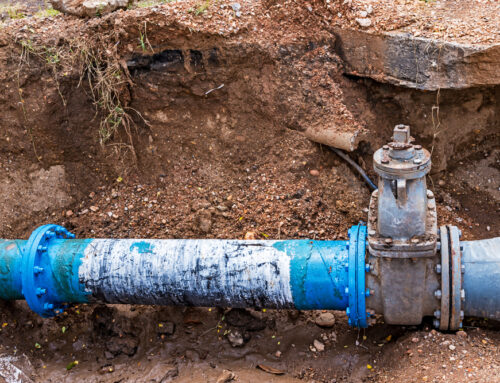This discussion seeks to unpack the complex layers of the lead poisoning crisis. We will examine its historical roots, the implications of lead service line corrosion, and the efforts mandated by the Environmental Protection Agency’s Lead and Copper Rule to mitigate this health risk. As we explore the various aspects of this crisis, it’s natural to wonder: why does lead poisoning still persist in America, despite our best efforts to fix it?
History of Lead Poisoning
The issue of lead poisoning is not a recent phenomenon; it can be traced back to the Roman Empire where lead was extensively used in constructing waterways. This usage led to the first recorded instances of lead toxicity, with signs appearing as early as the second century BC.
Over the centuries, the understanding of lead’s detrimental effects on human health has evolved significantly. By the 2000s, lead poisoning – especially in children – was acknowledged as a significant public health issue. Corrosion of lead service lines has surfaced as one of the primary culprits, with natural corroding agents enabling lead particles to leach into water supplies.
Costly efforts to address these concerns have led to remediation actions and policy interventions across multiple government tiers to manage lead corrosion.
Corrosion of Lead Pipes
Lead pipes play a significant role in today’s public health crisis. The corrosion of lead pipes contributes to the lead contamination in our water systems.
- Natural Corrosion: As time passes, lead pipes interact with natural corrosive elements in water, resulting in lead leaching into our water supply and contaminating the water we drink.
- Corrosion Control Measures: Both federal and local governments have made attempts to mitigate this through corrosion control strategies, but these have been inconsistent and often ineffective.
- Remediation Efforts: Despite millions of dollars being poured into remediation efforts, lead service lines remain an issue due to the sheer volume of these pipes that exist within our infrastructure.
This continues to be a significant hurdle in overcoming the lead poisoning crisis.
Lead Pipe Remediation Strategies
What can be done to reduce the widespread problem of lead in our water? The main solution lies in lead pipe remediation strategies, which focus on removing sources of lead exposure and replacing lead service lines with safer materials. This is crucial for preventing lead exposure.
| Strategy | Description |
| Removal | Eradicate substances that expose people to lead |
| Replacement | Substitute lead pipes with safer materials |
| Education | Inform the public about lead detection |
| Chemical Treatment | Use phosphates to prevent lead corrosion |
| Funding | Apply federal grants to ease financial burden |
Efforts are guided by EPA’s Lead and Copper Rule, including the setting of standards, chemical treatments, education, and lead pipe replacement initiatives.
Water Utilities and Lead Removal
Water utilities nationwide play a vital role in removing lead to keep drinking water safe. This responsibility involves following strict regulations, using advanced technology, and raising public awareness about lead safety.
Regulations: Utilities must comply with the EPA’s Lead and Copper Rule, which stipulates control measures and sets standards for lead levels in water.
Technology: Utilities use sophisticated treatment methods to minimize lead leaching, including the use of anti-corrosive additives.
Advocacy: Utilities play a key role in educating consumers about lead risks and the measures being taken to mitigate them.
Water utilities are on the front lines of the fight against lead poisoning, making our water safer one pipeline at a time.
Understanding EPA’s Lead and Copper Rule
Enacted by the Environmental Protection Agency, the Lead and Copper Rule serves as a pivotal regulatory framework in the battle against lead contamination in U.S. water supplies. It establishes maximum contaminant level goals, lead service line replacement requirements, and public education mandates to safeguard public health.
| Aspect | Description | Impact |
| Maximum Contaminant Level Goals | The LCR sets a zero contaminant goal for lead, urging utilities to eliminate lead contamination. | Sets a high standard for water quality, promoting public health. |
| Lead Service Line Replacement | Water utilities are required to replace lead service lines to reduce exposure. | Directly addresses the root cause of lead contamination. |
| Public Education | Utilities must inform customers about lead levels and potential health effects. | Fosters awareness, enabling individuals to take protective actions. |
Understanding the LCR’s facets empowers us to comprehend its role in mitigating the lead crisis.
Funding and Implementation of Remediation Efforts
Addressing the monumental task of lead pipe remediation necessitates substantial funding and strategic implementation. This effort involves a complex interplay of federal grants, utility budgets, and cost-shifting to consumers.
- Federal involvement: The U.S. government provides significant funding through grants like the Drinking Water State Revolving Fund. This financial aid is crucial for utility companies facing hefty remediation costs.
- Utility companies’ role: These entities shoulder a large part of the remediation cost, often undertaking long-term projects to replace lead service lines. They must balance this with maintaining affordable water rates for consumers.
- Consumer contribution: While government and utility efforts aim to mitigate consumer impact, some costs inevitably trickle down to consumers, typically through increased water bills or service fees.
Tackling America’s Silent Water Crisis
As lead poisoning persists in America’s water supply, it highlights the crucial need for continuous remediation efforts. Despite the EPA’s strict Lead and Copper Rule and the steadfast dedication of water utilities, the task remains immense. Addressing one issue often reveals another, emphasizing that the silent water crisis is ongoing. Therefore, sustained vigilance, funding, and comprehensive strategies are essential for a future without lead contamination.
Upgrade your water safety today with Behm Enterprises’ lead water service line replacement services. Contact us now for a safer tomorrow!




